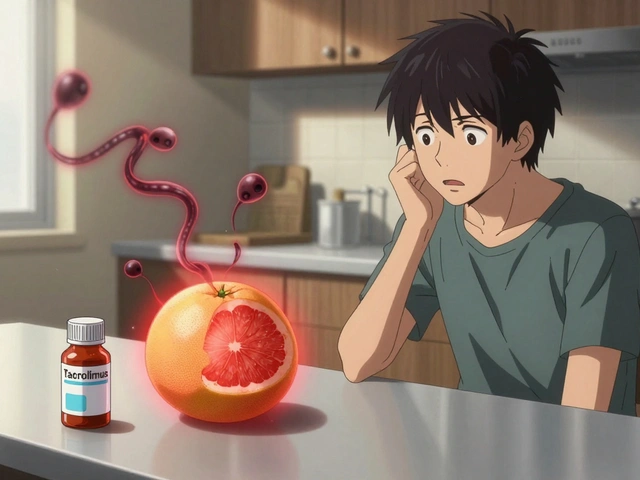Many people don’t realize that the medications they take for asthma, diabetes, or after an organ transplant can lead to a simple but painful mouth infection called oral thrush. It’s not contagious. It’s not caused by poor hygiene. It’s often a direct result of drugs that throw off the natural balance of microbes in your mouth. If you’re on inhaled steroids, antibiotics, or immunosuppressants, you’re at higher risk. The good news? It’s treatable-and often preventable.
What Causes Oral Thrush from Medications?
Oral thrush is a fungal infection caused mainly by Candida albicans, a yeast that lives harmlessly in most people’s mouths. But when something disrupts the balance-like certain medications-it can grow out of control. The most common culprits are:- Inhaled corticosteroids (like Advair, Flovent, Symbicort): Used by over 12 million Americans with asthma or COPD. These drugs suppress local immune responses in the mouth, letting Candida thrive.
- Broad-spectrum antibiotics (like amoxicillin, ciprofloxacin): Kill off the good bacteria that normally keep yeast in check.
- Immunosuppressants (like cyclosporine, tacrolimus): Taken by transplant patients and those with autoimmune diseases. These weaken your body’s ability to fight off infections.
- Cancer treatments (chemotherapy and radiation): Damage the lining of the mouth and reduce white blood cell counts, making infections easier to develop.
According to the NHS, about 5% of the general population gets oral thrush-but that number jumps to 20% in people using inhaled steroids. For transplant recipients or those on long-term antibiotics, the risk is even higher.
What Does Oral Thrush Look and Feel Like?
It’s not hard to spot. Symptoms usually appear within days to weeks after starting the medication:- White, creamy patches on the tongue, inner cheeks, or roof of the mouth
- Redness or soreness underneath the patches
- Cotton-like feeling in the mouth
- Loss of taste
- Cracking or redness at the corners of the lips
- Pain or difficulty swallowing (especially if the infection spreads to the esophagus)
Some people mistake it for food residue or plaque. But unlike plaque, thrush patches don’t brush off easily. If you scrape them, they often leave behind a raw, red, bleeding surface.
How Is Oral Thrush Treated?
Treatment depends on how severe it is, your overall health, and what medication caused it. Two main types of antifungals are used: topical and systemic.Nystatin: The First-Line Topical Treatment
Nystatin (sold as Mycostatin or Nilstat) is the most common starting point. It’s been used since the 1950s and works by punching holes in the yeast’s cell walls. The oral suspension is swished around the mouth and then spit out-never swallowed.Here’s how to use it right:
- Shake the bottle well.
- Measure 4-6 mL (about a teaspoon) using the provided dropper.
- Swish it around your mouth for at least 2 minutes. Don’t swallow it.
- Spit it out.
- Do this four times a day-after meals and before bed.
- Continue for 7-14 days, even if symptoms improve.
Why does timing matter? A 2022 study found that 42% of treatment failures happen because people swallow the liquid too quickly. You need contact time. The longer it touches the infected areas, the better it works.
Studies show nystatin cures 92% of mild to moderate cases when used correctly. It’s safe for kids, pregnant women, and seniors because less than 5% is absorbed into the bloodstream. The downside? The taste is chalky and unpleasant. Many users on Reddit and HealthUnlocked say they struggle with compliance because of it.
Fluconazole: For Severe or Recurrent Cases
If nystatin doesn’t work-or if the infection has spread to your throat or esophagus-doctors turn to fluconazole (Diflucan). It’s a pill you take once a day. It’s absorbed into your bloodstream and reaches all areas of the mouth and throat.Standard dose: 100-200 mg daily for 7-14 days. It’s more effective than nystatin-around 95% success rate-but comes with more risks:
- Can interact with 32 other medications, including blood thinners (warfarin), seizure drugs (phenytoin), and diabetes pills (sulfonylureas).
- May cause headaches, nausea, or stomach pain.
- Can affect liver function. Rare cases of severe liver damage have been reported.
- Not safe if you’re allergic to azole antifungals.
Fluconazole is the go-to for immunocompromised patients-like those with HIV or after transplants. But it’s not the first choice for healthy adults with mild thrush. The Infectious Diseases Society of America recommends reserving it for more serious cases.

Nystatin vs. Fluconazole: What’s the Difference?
| Feature | Nystatin | Fluconazole |
|---|---|---|
| Type | Topical (mouth rinse) | Systemic (oral pill) |
| Effectiveness | 89% for mild cases | 95% for all cases |
| Dosing | Four times daily | Once daily |
| Side Effects | Unpleasant taste, no systemic effects | Headache, nausea, possible liver issues |
| Drug Interactions | Minimal | 32+ common medications |
| Cost (generic, 30-day supply) | $15.79 | $23.49 |
| Safety in Pregnancy | Yes | Use only if benefits outweigh risks |
| Best For | Mild cases, children, elderly, people on multiple meds | Severe cases, immunocompromised, esophageal thrush |
Cost isn’t the only factor. Nystatin is cheaper and safer, but harder to stick with. Fluconazole is easier to take, but carries more risks. Your doctor will pick based on your health history and how bad the infection is.
How to Prevent Oral Thrush Before It Starts
The best treatment is no treatment at all. Prevention is simple, but often ignored.- Rinse your mouth after using inhaled steroids. The NHS says this cuts thrush risk by 65%. Use water-not just swishing, but actually rinsing and spitting. Don’t swallow.
- Use a spacer with your inhaler. A spacer device helps the medicine go straight to your lungs instead of settling in your mouth.
- Brush twice daily and floss. Good oral hygiene keeps yeast from taking hold.
- Try xylitol products. Chewing gum or mints with xylitol reduce Candida growth by 40%, according to a study in the Journal of Dental Research.
- Control blood sugar if you have diabetes. High glucose feeds yeast. Keeping HbA1c below 7.0% lowers your risk significantly.
- Consider probiotics. A 2023 study in Nature Microbiology showed that taking Lactobacillus reuteri alongside antifungal treatment reduced recurrence by 57%.
- Visit your dentist regularly. Every 6 months. Dentists spot early signs of thrush before it gets worse.

New Developments in Treatment and Prevention
The field is evolving. In March 2023, the FDA approved a new product: Mycolog-II, a mucoadhesive nystatin tablet that sticks to your mouth for up to 4 hours. That means fewer doses per day and better results-94% cure rate in trials.Also, resistance is becoming a problem. Fluconazole resistance in Candida has doubled since 2010, rising from 3% to 12% in 2022. That’s why doctors are starting to culture samples in recurrent cases instead of just prescribing more pills.
Three new antifungals are in Phase II trials, designed to target yeast without harming good bacteria or causing liver damage. These could change the game in the next few years.
What If Treatment Doesn’t Work?
If your thrush doesn’t improve after 14 days of nystatin-or if it comes back right after stopping fluconazole-talk to your doctor. Possible reasons:- You didn’t use the medication correctly (swallowed nystatin too soon).
- You’re still using the triggering medication without rinsing.
- You have an undiagnosed immune issue (like undiagnosed HIV or uncontrolled diabetes).
- The strain is resistant to fluconazole.
Your doctor may order a mouth swab to check for resistant strains or look for underlying conditions. Don’t ignore recurring thrush-it’s often a warning sign.
Can oral thrush go away on its own?
Sometimes, yes-especially if it’s mild and you stop the triggering medication. But waiting isn’t recommended. Left untreated, thrush can spread to the esophagus, causing pain and difficulty eating. In people with weakened immune systems, it can become life-threatening. Treatment is fast, safe, and effective-there’s no reason to wait.
Is oral thrush contagious?
Not in the usual sense. You can’t catch it from kissing or sharing a cup. But the yeast that causes it (Candida) is naturally present in everyone’s mouth. It only becomes a problem when your body’s balance is disrupted-by medication, illness, or poor oral care. So while you can’t "catch" it from someone else, you can develop it if your own system is out of balance.
Can children get oral thrush from medications?
Yes. Babies on antibiotics or children on inhaled steroids for asthma can develop thrush. Nystatin suspension is safe for infants and is often the first choice. For babies, it’s usually applied with a dropper or cotton swab directly to the white patches. Always follow your pediatrician’s dosing instructions-never guess.
Does drinking alcohol affect antifungal treatment?
With nystatin, no-it’s not absorbed, so alcohol won’t interfere. With fluconazole, it’s not dangerous, but alcohol can worsen side effects like nausea and dizziness. It’s best to avoid it while taking fluconazole, especially if you’re prone to stomach upset or liver issues.
How long does it take for oral thrush to clear up?
Most people see improvement within 3-5 days. Symptoms usually disappear completely in 7-14 days with proper treatment. But don’t stop early-even if it feels better. Stopping too soon lets the yeast come back. Always finish the full course.
Can I use mouthwash to treat oral thrush?
Regular alcohol-based mouthwashes can make it worse by killing off good bacteria. Some antiseptic rinses (like chlorhexidine) may help prevent it, but they don’t treat active thrush. Only use antifungal treatments prescribed by your doctor. Don’t self-treat with over-the-counter mouthwashes.
What Should You Do Next?
If you’re on a medication that increases your risk of oral thrush:- Rinse your mouth with water after every dose of inhaled steroids.
- Ask your doctor about using a spacer with your inhaler.
- Start using xylitol gum or lozenges daily.
- Keep up with your dental checkups.
- If you notice white patches or soreness, don’t wait. See your doctor or dentist right away.
Oral thrush is common-but it’s not inevitable. With the right prevention and quick action, you can avoid the discomfort and keep your mouth healthy while managing your other conditions.





Callum Breden
October 29, 2025 AT 18:48This article is a textbook example of medical misinformation dressed up as helpful advice. Nystatin? That’s a 1950s relic. Fluconazole resistance is rising, and yet you’re still pushing the chalky, useless swish-and-spit nonsense? You’re not helping people-you’re enabling complacency. If you’re on immunosuppressants and getting thrush, you’re not supposed to be swishing around antifungals-you’re supposed to be reevaluating your entire drug regimen. This is lazy medicine.
Mansi Gupta
October 29, 2025 AT 20:02Thank you for this thorough and well-researched breakdown. I’ve been managing asthma with inhaled steroids for over a decade and never realized how simple rinsing could be so effective. I’ll start using a spacer and xylitol gum immediately. It’s reassuring to know prevention is within reach, even with long-term medication use.
Erin Corcoran
October 30, 2025 AT 06:01OMG YES!! I had thrush after antibiotics last year and it was the WORST 😩 Nystatin tasted like chalky sadness but it worked! I started chewing xylitol gum after every meal and no more recurrence. Also-SPACER IS A GAME CHANGER. My pulmonologist didn’t even mention it until I asked. 🙌 #oralthrushawareness
shivam mishra
October 31, 2025 AT 21:15As a pharmacist in Mumbai, I see this daily. Patients on steroids or immunosuppressants often skip rinsing because they think it’s just ‘mouth stuff.’ But thrush is a red flag-it’s not just discomfort, it’s a sign of systemic imbalance. I always recommend rinsing with water immediately after inhalers, using a spacer, and adding probiotics like L. reuteri. Simple, cheap, and effective. Also, dentists are underutilized here-many patients don’t visit until it’s severe. Early detection saves so much pain.
Scott Dill
November 1, 2025 AT 22:04Wait-so I’ve been brushing my teeth after my inhaler and thinking I’m covered? Nope. RINSING with water? That’s it? No fancy mouthwash? No scraping? Just… spit? I feel like I’ve been doing this wrong for 5 years. This is the most useful thing I’ve read all month. Thanks for the clarity. Going to buy a spacer tomorrow.
MOLLY SURNO
November 2, 2025 AT 19:40Thank you for highlighting the importance of dental checkups. I dismissed the white patches on my tongue as ‘just stress’ until my hygienist pointed out the classic thrush appearance. It was mild, but I had no idea how closely linked it was to my prednisone. Prevention truly is better than cure.
Alex Hundert
November 3, 2025 AT 15:54Fluconazole isn’t just for severe cases-it’s the only thing that works if you’ve got recurrent thrush while on tacrolimus. I’ve had it three times since my transplant. Nystatin? Didn’t touch it. Fluconazole cleared it in 3 days. Yes, there are interactions-but so are the risks of leaving it untreated. Don’t let fear of side effects stop you from treating a real infection.
Emily Kidd
November 4, 2025 AT 10:15so i was on abx for a sinus infection and got thrush… then i started chewin xylitol gum and it went away in like 3 days. also, i swear by the nystatin but it tastes like my grandma’s basement. i mix it with a little apple sauce to make it bearable. also-dont use peroxide mouthwash. it burns like hell and makes it worse. just rinse with water. its dumb simple but no one tells you.
Justin Cheah
November 5, 2025 AT 22:55Let’s be real-this whole thrush thing is a Big Pharma distraction. Why are we giving people steroids that kill their immune system in the first place? Why not fix the root cause instead of slapping on antifungals like band-aids? And why is fluconazole so expensive? Who profits? The same people who make the inhalers and the immunosuppressants. The CDC knows this. The FDA knows this. They just won’t admit it. This isn’t medicine-it’s a revenue stream disguised as healthcare. And you’re all just swallowing it. Literally.
caiden gilbert
November 7, 2025 AT 06:50My mouth’s been feeling like a cotton sock dipped in chalk since I started Flovent. I thought I was just being dramatic. Turns out I was just… infected. I’m not gonna lie-I thought this was gonna be some 10-step ritual with witch hazel and tea tree oil. But nah. Rinse. Spit. Spacer. Xylitol. That’s it. Like… the universe just handed me a cheat code. I feel like I’ve been fighting a ghost this whole time. Thanks for the clarity. Now I can actually breathe.